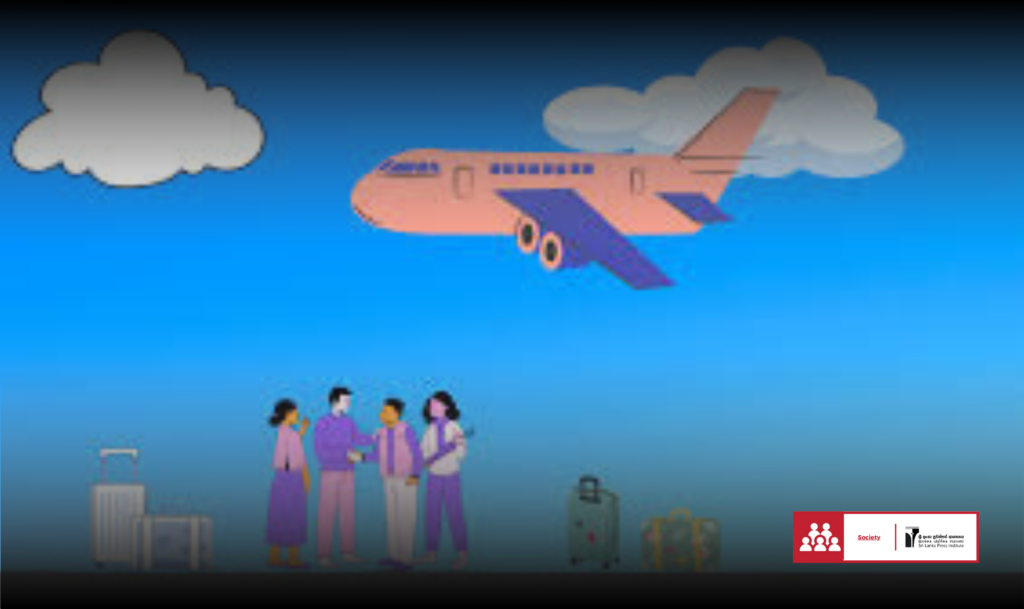Sri Lanka’s Youth Migration Tragedy
by Sheneth Srimal

The long queues observed these days for visa applications reveal the scale and depth of a tragedy faced by our nation. The severe economic crisis Sri Lanka experienced recently, along with the societal issues of lacking suitable spaces for deserving individuals, has led many frustrated individuals to seek foreign opportunities. This has evolved into a serious social issue. Below are a few perspectives that have been shared on this timely social-economic crisis and a few options that could be considered in addressing this challenge.
The Necessity for Fulfilling Aspirations for Quality Living Leading to Youth Migration in Sri Lanka
Currently, youth migration in Sri Lanka has become an increasingly significant trend due to various factors. The primary drivers of this migration are not just the desire to elevate economic status but also the need to fulfill aspirations for a quality life, both personally and professionally. In this context, factors such as education, career development, and socio-economic well-being take precedence (Gunaratna, 2023).
Youth Migration in Sri Lanka: Social and Economic Setbacks
Sri Lanka, a country with a rich cultural heritage, faces various socio-economic setbacks, including significant income inequality, limited career opportunities, and a lack of economic stability and secure livelihoods. These factors hold substantial importance within the societal structure (Dias, 2022). A considerable percentage of total migration comprises youth, with Australia, Canada and the Middle Eastern countries often being primary destinations. According to the Sri Lanka Bureau of Foreign Employment (SLBFE) report, by 2023, around 40% of the migrating population is aged between 18-35 (SLBFE, 2023).
Primary Causes of Migration
The main reasons driving Sri Lankan youth to migrate have been identified as follows:
- Standard of Living and Aspirations
Many youths, especially those from urban areas, focus on attaining global standards of living and aspire toward secure lives, similar to those found in more developed countries. Within this context, they find the existing social and governmental environment insufficient for fulfilling these aspirations (Wickramasinghe, 2021).
- Educational and Career Development
The lack of specialized programs and progressive features within the Sri Lankan public and private education systems compels youth to seek education abroad. In many cases, foreign education aligns better with professional needs in Sri Lanka, making migration an attractive option (Dias, 2022).
- Economic Stability and Social Security
Due to income disparities and wage inequalities in Sri Lanka, many youths are inclined to seek economic stability and social security abroad. Particularly, young people from economically pressured families recognize foreign opportunities as valuable (Gunasekara, 2021).
Social and Economic Setbacks for Sri Lanka
Youth migration has led to numerous economic repercussions and setbacks in Sri Lanka’s social and developmental landscape. These impacts can be recognized across various elements within the country’s socio-economic framework. Issues such as family connections, household income, and the reduction in youth migration within urban or highly populated areas have been noted within the society (Gunaratna, 2023).
Policy Recommendations
Here are a few policy recommendations that could be taken into account in designing strategies to mitigate the socioeconomic crisis caused by youth migration:
- Strengthening Economic and Urban Development Programs
Regional and urban-level development programs geared toward youths should be prioritized as a main social avenue. Through this, it may be possible to create opportunities for youth to achieve secure futures within Sri Lanka.
- Development of Localized Higher Education and Responsive Programs
Emphasizing localized, quality higher education programs and introducing reforms to align with Sri Lanka’s unique workforce needs could help provide young people with proper career guidance (Ranasinghe, 2022).
- Assistance Programs for Returning Migrants
A well-structured assistance program could be established to support those who choose to return to Sri Lanka and contribute to economic stability. Such programs would serve as valuable support mechanisms for their reintegration.
Conclusion
Youth migration represents a significant social and economic setback for Sri Lanka. Addressing aspirations and needs related to migration, along with developing regional economic strategies, structured migration policies, and localized programs for youth, would contribute positively to the socio-economic success of future Sri Lanka.
Sources:
- Gunaratna, C. (2023). “A Study on Youth Migration and Economic Stability.” Social Report of Sri Lanka.
- Ranasinghe, M. (2022). “Overseas Education and Migration in Sri Lanka.” Educational Review.
- Wickramasinghe, I. (2021). “Aspirations and Youth Migration.” Youth Social Research.
- SLBFE. (2023). Report by the Sri Lanka Bureau of Foreign Employment.
- Gunasekara, P. (2021). “Youth Migration and the Economy.” Domestic Economic Studies







